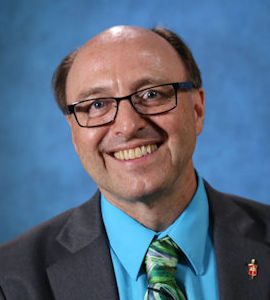In this month’s Joyful Journey, Bishop David Bard says, “In the midst of life, we are in death.” Then he proclaims with joy, ” Death is real, so, too, resurrection.” …

“In the midst of life, we are in death.” These words begin the century’s-old graveside liturgy of the church. In the midst of life, we are in death. We see it all around us. Over 550,000 people have died in the United States from COVID-19. Gun violence has taken lives in mass shootings in Atlanta, Boulder, and Southern California. In the same week that a former police officer is on trial in Minneapolis for the killing of George Floyd in Boulder, a police officer is mourned, his death the result of response to a shooting. The pandemic has brought with it a significant rise in drug-related deaths. All of these are beyond our more usual encounters with death – the loss of loved ones. The coronavirus pandemic has not stopped the death and dying of family and friends from other causes.
There is literal physical death, and then there are the figurative ways we die, ranging on a continuum from the kind of small emotional deaths that occurs when life disappoints, or we fail, or we are unfairly criticized, or the object of ridicule or we are devalued for how we look or where we come from, to a certain kind of soul death that accompanies significant trauma. Dreams can die, leaving us feeling less alive. When there is a division in The United Methodist Church, we will experience a kind of death.
In the midst of life, we are in death.
It is also just as true to say that in the midst of life, we are in resurrection. Easter is not meant to paper over the very real pain of death, deaths great and small. The crucifixion of Jesus is painful and brutal. Witnessing it, his family and friends would have been traumatized; maybe they even experienced a kind of soul death. There is the silence of Saturday, a time to feel that death. But then, resurrection. The stone rolled away from the tomb. “He has been raised; he is not here.” Death is real, so, too, resurrection.
With resurrection comes hope. Death does not have the final word. Life does. We can look death straight in the eye and work for life. We can be forces for healing. We can be forces for justice. We can be forces for reconciliation. We can be forces for peace. We can help those whose hearts and souls have been wounded, sharing the good news that God’s grace and love offer healing and new life.
What is even more remarkable is that we have the courage to embrace certain kinds of dying necessary for new life assured of resurrection. Change is a kind of dying. What we have known, what is familiar, has to die. On the other side, new life. “Unless a grain of wheat falls into the earth and dies, it remains just a single grain; but if it dies it bears much fruit.” (John 12:24)
The question Dietrich Bonhoeffer poses in The Cost of Discipleship is perennial. “And if we answer the call to discipleship, where will it lead us? What decisions and partings will it demand?” What deaths might we need to embrace in courage and hope? We know that any death will come with pain, even when we embrace certain kinds of death necessary to create space for new life. In the midst of life, we are in death. We also trust that there is resurrection, new life. In the midst of life, resurrection.
What kinds of death have you experienced for which you need to hear the good news of resurrection, of the resurrection power of God’s love? What kinds of death might we need to willingly embrace with the courage to create new space for the resurrection power of God’s love – in our lives, in our churches, in our communities, in our world?
In the midst of life, we are in death. In the midst of life, we are in resurrection. And in the end, we are Easter people. “Every day to us is Easter, with its resurrection song.”
I am with You on this Joyful Journey in the Midst of Life.